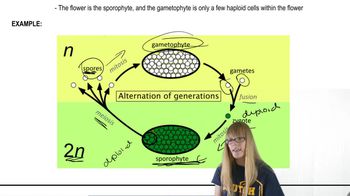Two parents plan to have three children. What is the probability that the children will be two girls and one boy?
Table of contents
- 1. Introduction to Genetics51m
- 2. Mendel's Laws of Inheritance3h 37m
- 3. Extensions to Mendelian Inheritance2h 41m
- 4. Genetic Mapping and Linkage2h 28m
- 5. Genetics of Bacteria and Viruses1h 21m
- 6. Chromosomal Variation1h 48m
- 7. DNA and Chromosome Structure56m
- 8. DNA Replication1h 10m
- 9. Mitosis and Meiosis1h 34m
- 10. Transcription1h 0m
- 11. Translation58m
- 12. Gene Regulation in Prokaryotes1h 19m
- 13. Gene Regulation in Eukaryotes44m
- 14. Genetic Control of Development44m
- 15. Genomes and Genomics1h 50m
- 16. Transposable Elements47m
- 17. Mutation, Repair, and Recombination1h 6m
- 18. Molecular Genetic Tools19m
- 19. Cancer Genetics29m
- 20. Quantitative Genetics1h 26m
- 21. Population Genetics50m
- 22. Evolutionary Genetics29m
2. Mendel's Laws of Inheritance
Probability and Genetics
Problem 6a
Textbook Question
Consider the cross AaBbCC × AABbCc.
How many different gamete genotypes can each organism produce?
 Verified step by step guidance
Verified step by step guidance1
Step 1: Understand the problem. The question asks how many different gamete genotypes can be produced by each organism in the given cross. Gametes are formed through meiosis, where alleles segregate independently according to Mendel's laws.
Step 2: Analyze the genotype of the first organism (AaBbCC). For each gene, determine the number of allele combinations that can be passed to the gametes. Gene A has two alleles (A and a), Gene B has two alleles (B and b), and Gene C has only one allele (C, since it is homozygous). The total number of gamete genotypes is calculated by multiplying the number of allele combinations for each gene: 2 × 2 × 1.
Step 3: Analyze the genotype of the second organism (AABbCc). Gene A has only one allele (A, since it is homozygous), Gene B has two alleles (B and b), and Gene C has two alleles (C and c). The total number of gamete genotypes is calculated by multiplying the number of allele combinations for each gene: 1 × 2 × 2.
Step 4: Use the formula for calculating the number of gamete genotypes: \( \text{Number of gamete genotypes} = \text{Number of allele combinations for Gene A} \times \text{Number of allele combinations for Gene B} \times \text{Number of allele combinations for Gene C} \). Apply this formula to each organism's genotype.
Step 5: Summarize the results. The first organism (AaBbCC) produces gametes based on the combinations of alleles from its genotype, and the second organism (AABbCc) produces gametes based on its genotype. Multiply the allele combinations for each gene to determine the number of gamete genotypes for each organism.
 Verified video answer for a similar problem:
Verified video answer for a similar problem:This video solution was recommended by our tutors as helpful for the problem above
Video duration:
2mPlay a video:
Was this helpful?
Key Concepts
Here are the essential concepts you must grasp in order to answer the question correctly.
Gamete Formation
Gamete formation is the process by which organisms produce reproductive cells (gametes) through meiosis. Each gamete carries half the genetic information of the parent organism, resulting in a unique combination of alleles. Understanding how alleles segregate during gamete formation is crucial for predicting the genetic outcomes of crosses.
Recommended video:
Guided course

Formation of Plant Gametes
Independent Assortment
Independent assortment is a principle of genetics stating that alleles for different traits segregate independently of one another during gamete formation. This means that the inheritance of one trait does not affect the inheritance of another, allowing for a variety of combinations in the gametes produced by an organism.
Recommended video:
Guided course

Gamete Genetics and Independent Assortment
Punnett Square
A Punnett square is a diagram used to predict the genotypes of offspring from a genetic cross. By organizing the possible gametes from each parent, it allows for a visual representation of how alleles combine, making it easier to calculate the number of different genotypes that can arise from a given cross.
Recommended video:
Guided course

Chi Square Analysis
Related Videos
Related Practice
Textbook Question
608
views


